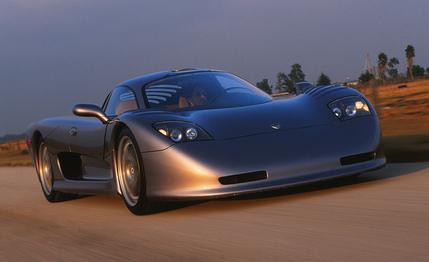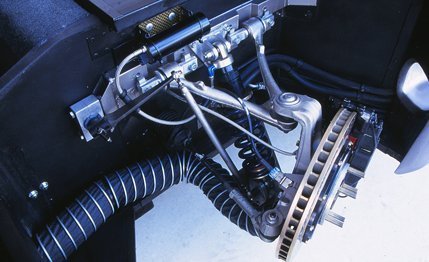
 First Drive Review
First Drive Review




Warren Mosler knows many things. He understands securities and bond trading. He has a plan for advancing the prosperity of the Palestinian state. He will cheerfully explain global macroeconomics until you want to throw yourself into the spinning blades of an Everglades fan boat.
But he doesn't know if the Mosler MT900 will sell.
"What do you think?" the bazillionaire entrepreneur/economist and oft-doubted carbuilder asks, standing by the first copy of his creation.
Well, we don't know, Warren. Let's run the numbers: 2590 pounds, 350 horsepower, 0 to 60 in 3.5 seconds, 70 mph to a standstill in 149 feet, 12 seconds flat in the quarter-mile, 1.02 g on the skidpad, and on the hand-lettered, gilt-edged sticker is the $163,840 bottom line, should the car ever come to market. Seems like those numbers will add up for a lot of sick-rich players in the exotic-car market.
The down-on-power, unsorted prototype we tested at Sebring during its first weekend of shakedown laps does in fact accelerate quicker, brake harder, and corner sharper than a Ferrari 360 Modena; likewise, it slaps around a Lamborghini Diablo 6.0, then asks for some $136,000 in change. How could the MT900 not sell?
It is poignant that Mosler—a person in whose presence you know, finally, that you are not the smartest guy in the room—doubts his instincts on this score. But Mosler has been slapped around himself in his 15 years of building cars.
Yes, that Mosler, he of the Consulier, Intruder, and Raptor, those super-fast, lightweight, mid-engined sports cars that are routinely banned from endurance racing for being unbeatable, and whose visages are themselves a test of endurance. No one doubts that Mosler can build fast cars. His 45,000-square-foot hobby shop in Riviera Beach, Florida, has amassed a display case full of trophies from places like Sebring, Moroso, and Nelson Ledges. A Lingenfelter-powered Raptor won the 1999 edition of Car and Driver's One Lap of America (before our own Brock Yates decorously disinvited Mosler from the 2000 soiree). In fact, Mosler is building a full-race version of the new car, the MT900R, to compete in the 24 Hours of Daytona, to yet again affirm his carbuilding acumen.
The issue is one of aesthetics. Mosler's cars have been, heretofore, just ugly. Mosler, slightly anguished and bemused, doesn't understand it. "I like the way the Raptor looks. My cars are designed by the stopwatch."


Mosler's stylistic sense is thus governed by his engineering determinism, for which he has no off switch. He looks at the Raptor's split window, which he says cleverly reduces frontal area and approaches the ideal angle of incidence with minimal solar gain, and sees a thing of beauty. Most everybody else sees an overturned rowboat.
In a less agile mind, this inability to tell a beautiful car from a stack of pancakes might be a tragic flaw. But Mosler has come to accept his blind spot, managed to make it a strength of character. "I know I can build a car that will win every race, but not a car that everyone will want to buy." This humility—and, likely, his economist's need to make a business case for his perennially money-losing enterprise, Mosler Automotive—made him receptive when Rod Trenne came calling.
Trenne, 30, is among the first generation of automotive designers to set aside paper and clay and work entirely in cyberspace. As a junior member of the C5 Corvette design team back in 1994, Trenne stayed after hours at the office in Warren, Michigan, designing his dream supercar on the new Unigraphics Solutions software system. This is a staggeringly complex suite of design and engineering software that can execute solid modeling, kinematics analysis, and more, then spit all the math data out to toolmaking CNC machines. With the right wetware at the helm, Unigraphics can produce a whole car design, right down to the cigarette lighter, in less time than it used to take GM just to design that lighter.